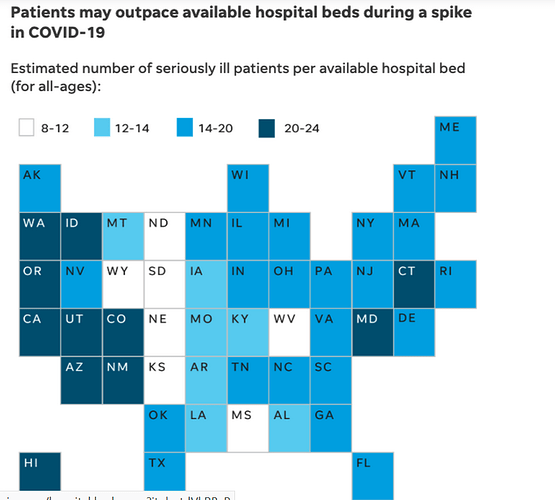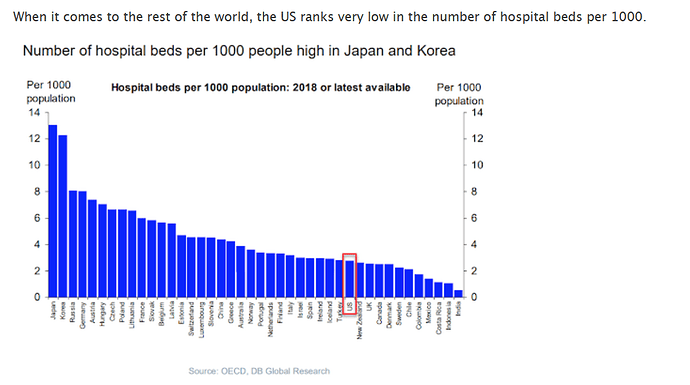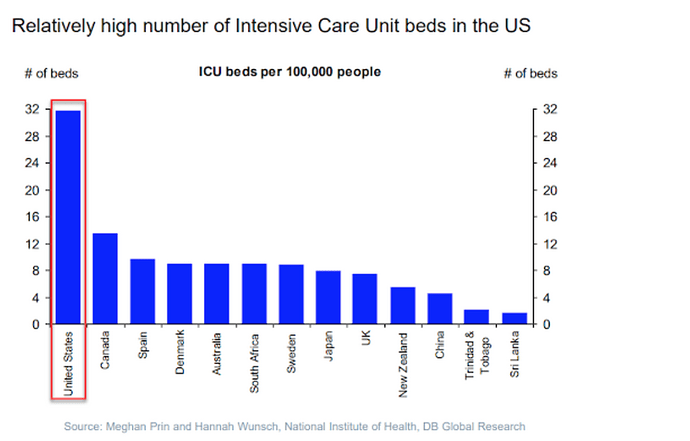Jim,
As a doctor, does it concern you that US wlll be running out of hospital beds if virus spike despite having the highest ICU beds percentage in the world?
Regards
James
“No State Is Prepared” - Mapping Where Hospitals Will Run Out Of Beds First If Virus Cases Spike
by Tyler Durden
Sat, 03/14/2020 - 18:05
A USA Today analysis of American Hospital Association (AHA) hospital bed data shows that if confirmed Covid-19 cases and deaths follow similar growth curves as in China, Italy, and Iran, there could be six patients for every existing hospital bed. This means that no hospital system in the US is prepared for a pandemic.
“Unless we are able to implement dramatic isolation measures like some places in China, we’ll be presented with overwhelming numbers of coronavirus patients – two to 10 times as we see at peak influenza times,” said Dr. James Lawler, an infectious disease researcher at the University of Nebraska Medical Center.
Lawler warned that “no hospital has the current capacity to absorb” a massive surge of Covid-19 infections.
USA Today estimates that 23.8 million Americans could be infected. That number is based on an infection rate of 7.4%, similar to the common flu. Some experts say the infection rate could be much higher.
The Johns Hopkins Center for Health Security says infections could hit 38 million, including 9.6 million who will need to be hospitalized, and about 33% of whom would need ICU-level care.
With an infection rate unclear, USA Today’s analysis used that of a mild flu season. It said if everyone in the US who gets infected is hospitalized, that would be 4.7 million patients, which is about 6 per every hospital bed.
The fast-spreading virus could overwhelm the US’ healthcare system if confirmed cases and deaths surge in a 2-3-week period, as it did in China, Italy, and Iran. Currently, Italy’s health care system has been crippled with the lack of hospital beds and respirators. The result of not providing ICU-level treatment to the most critical patients has resulted in the country’s extraordinarily high 6.8% mortality rate.
The doomsday scenario that could play out in the US is an overburden healthcare system, where the most vulnerable cannot get ICU-level treatment, leading to a mortality rate comparable to Italy.
“When hospitals become much more crowded, literally stretched beyond capacity, if I have a heart attack, will I be able to get care? If I have an auto accident, will I get care? How do we triage that?” said Michael Osterholm, director of the Center for Infectious Disease Research and Policy at the University of Minnesota. “We can’t approach this like I approach a game of checkers with my 10-year-old grandson,” he added. “We have to approach this like a chess master thinking 10 to 15 moves down the board.”
Many hospital systems across the US aren’t designed to handle a mass influx of patients from a viral outbreak, indicating that no state is ready for a pandemic.
During the next outbreak, USA Today notes that many West Coast states would experience 20-24 seriously ill patients per available hospital bed. The odds of getting a bed are significantly higher in Rocky Mountain and Plains states. As for the East Coast, sick patients in Maryland and Connecticut would have the most difficulty in obtaining a bed.


